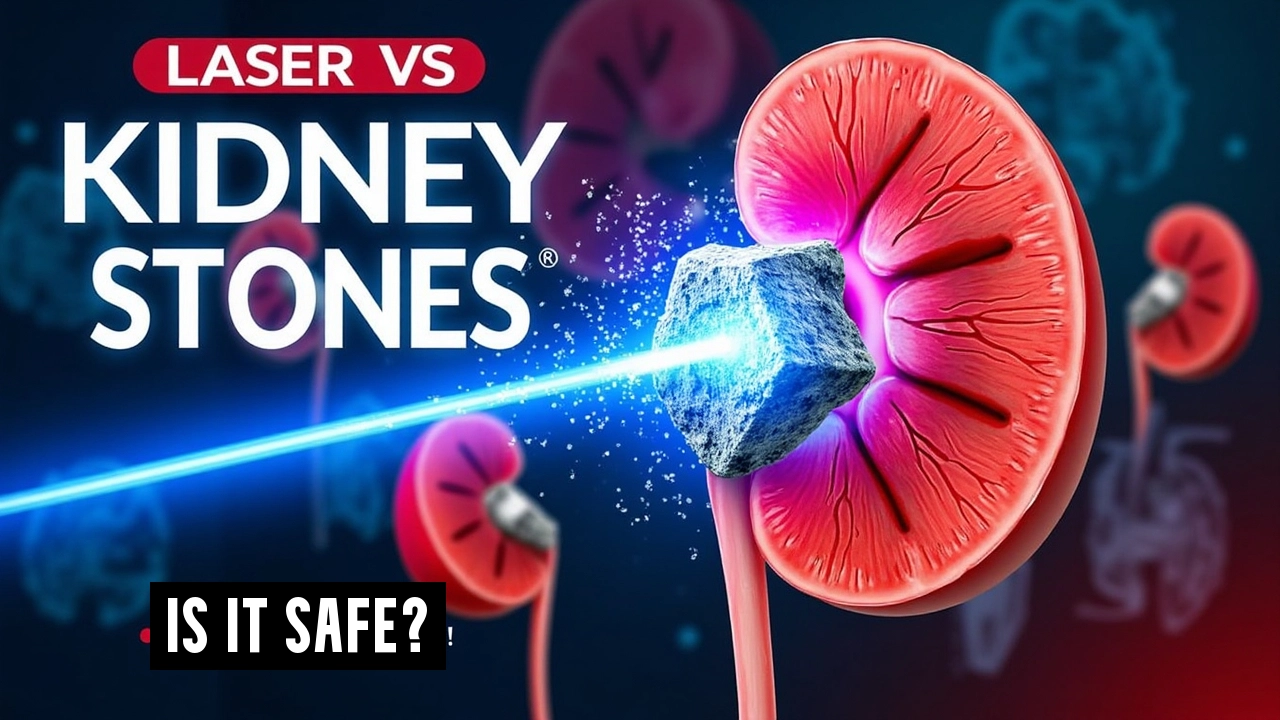Laser treatment for kidney stones is safe and effective. Urologists use it to target and break stones accurately. This method causes little damage to nearby tissue. Recovery is fast, so many patients prefer it.
“I was nervous about getting a laser procedure, but honestly it was the easiest part of my kidney stone journey. I was home the same day, and within 24 hours, I felt like myself again. I passed the fragments with minimal pain.”
James M., 42, Houston, TX
Kidney stones can feel like small boulders causing pain in your body. If you’ve felt that sharp pain in your back or side, you know how urgent it is to find relief. A common treatment in urology is laser lithotripsy. This is often called laser treatment for kidney stones. But is it safe? Let’s dive into what you need to know.

The Problem: When Kidney Stones Demand More Than Just Painkillers
Kidney stones can range from a minor nuisance to a full-blown medical emergency.
What Are Kidney Stones?
- Hard mineral and salt deposits formed inside the kidneys.
- Common types include calcium oxalate, uric acid, struvite, and cystine stones.
When Are They a Problem?
- Stones larger than 5mm often can’t pass on their own.
- Symptoms include:
- Severe flank pain
- Blood in urine
- Nausea or vomiting
- Fever and chills (if infection is present)
Why Some Stones Need Intervention
- Risk of obstruction in the ureter
- Recurrent infections
- Potential kidney damage over time
When Lifestyle Changes and Meds Aren’t Enough
- Hydration and dietary changes help prevent stones.
- Medications like alpha-blockers may aid small stone passage.
- But for persistent or large stones, laser treatment is often the next step.
The Solution: Understanding Laser Treatment (Laser Lithotripsy)
Laser treatment, especially Holmium:YAG laser lithotripsy, has changed how we treat stubborn stones.
What Is Laser Lithotripsy?
- A minimally invasive procedure that uses a laser fiber inserted via a ureteroscope to break stones into tiny fragments.
- No surgical incision required.
- Usually performed under general anesthesia.
Benefits of Laser Treatment
- Precise targeting reduces risk to surrounding tissues.
- Works on all stone types, regardless of composition.
- Faster recovery than open surgery.
- Often outpatient-based (same-day discharge).
Safety Profile: What Experts Say
- Considered one of the safest and most effective stone removal methods.
- Rare complications include:
- Urinary tract infection (UTI)
- Ureteral injury
- Temporary bleeding
- According to a 2023 study in the Journal of Urology, laser lithotripsy had a 90% success rate with a low complication profile.
Repeatability and Long-Term Impact
- Stones may recur depending on patient factors, but laser treatment itself doesn’t increase recurrence risk.
- Post-procedure stone analysis helps tailor future prevention strategies.
The Steps Involved in Laser Stone Removal
So how exactly does this laser magic work in a clinical setting?
Pre-Procedure Prep
- Imaging tests: CT scan or ultrasound to locate the stone.
- Blood and urine tests to rule out infection.
- Fasting instructions and anesthesia clearance.
The Procedure
- Ureteroscope inserted via the urethra into the urinary tract.
- Laser fiber targets the stone, fragmenting it into dust or extractable pieces.
- Sometimes a stent is placed to help urine flow post-op.
Recovery Timeline
- Minimal post-op pain (mild burning during urination for 1–2 days).
- Back to normal activities in 2–5 days.
- Follow-up includes:
- Imaging to confirm stone clearance
- Possible stent removal within a week
Risks and How They’re Managed
- UTIs managed with antibiotics.
- Stent discomfort relieved by medications or early removal.
- Rare ureter damage repaired via minimally invasive techniques.
Real Case Studies & Outcomes
Hearing from real patients can ease anxiety and help manage expectations.
“I typically recommend laser lithotripsy for stones in the lower urinary tract or when ESWL has failed. It’s especially useful for hard stones or those located in the ureter,” says Dr. Ana Patel, MD, a board-certified urologist.
“It’s incredibly safe and very effective even for stones that are otherwise difficult to treat.”
Case Study 1: 52-Year-Old Male with 8mm Calcium Oxalate Stone
- Tried hydration and alpha-blockers; no success.
- Laser lithotripsy is performed in under 60 minutes.
- Discharged the same day, back to work in 3 days.
- Stone-free on follow-up CT.
Case Study 2: 34-Year-Old Female with Recurrent Uric Acid Stones
- Prior ESWL failed due to stone density.
- Laser lithotripsy achieved complete fragmentation.
- Customized diet plan implemented post-op.
- No recurrence at the 1-year check-in
What the Research Shows
- A study in The Lancet Urology found that laser treatment is more effective than extracorporeal shock wave lithotripsy (ESWL) for stones over 10 mm.
- Complication rate is under 5% in experienced centers.
Frequently Asked Questions (FAQs)
Is laser treatment painful?
- The procedure itself is painless due to anesthesia. Some mild discomfort during recovery is normal but manageable.
How long does the procedure take?
- Typically 30–90 minutes, depending on stone size and number.
Is hospitalization required?
- Usually outpatient, though some complex cases may require overnight observation.
Will I need it more than once?
- Possibly, if multiple or recurrent stones are present. The procedure itself is safe to repeat.
What’s recovery like?
- Most patients resume normal activities within a few days. Staying hydrated and following dietary advice can speed recovery.
“People Also Ask” Questions to Target
- What are the side effects of laser kidney stone removal?
- How long does it take to recover from laser lithotripsy?
- Is laser lithotripsy better than shock wave treatment?
- Can kidney stones come back after laser treatment?
- Is laser lithotripsy safe for elderly patients?
Credible Sources to Cite
- American Urological Association (AUA)
- National Institute of Diabetes and Digestive and Kidney Diseases (NIDDK)
- The Journal of Urology (peer-reviewed clinical studies)
- Mayo Clinic’s Urology Division
- The Lancet Urology
Key Takeaways
- Laser treatment for kidney stones is generally safe, effective, and minimally invasive.
- It’s particularly useful for stones that are too large, dense, or painful to pass naturally.
- Recovery is quick, and recurrence can be minimized with preventive strategies.

